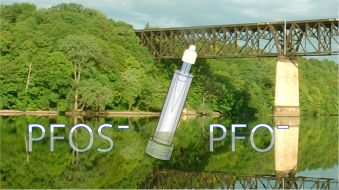

Main navigation | Main content
07/10/2013
Recent research from the research group of Professor
Perfluorocarbon (PFC) surfactants are used for a wide range of applications such as the production of polymers, lubricants, paints, polishes, cookware, and fire-retarding foams. However, because of their unique chemical stability, they don't easily biodegrade, are persistent in the environment, and can be found worldwide in surface waters and animal tissues. PFC surfactants with long alkyl chains such as perfluorooctanoate (PFO–) and perfluorooctanesulfonate (PFOS–) are of particular environmental concern.
In an article published in Analytical Chemistry, Li Chen, Ph.D., and Chunze Lai, Ph.D., from the research group of Professor Philippe Buhlmann, report on the development of ion-selective electrodes (ISEs) as sensors for PFO– and PFOS– with detection limits as low as 70 parts per trillion (ppt). This opens a venue to monitor PFO– and PFOS– continuously on-site to study their transport and fate in the environment. Alternatively, quick and uncomplicated pre-screening of large numbers of samples on-site may be performed with these electrodes prior to the tedious and time-consuming off-site analysis of much smaller numbers of selected samples with conventional methods of analysis, such as liquid chromatography–tandem mass spectrometry.
To demonstrate a real life application of these electrodes, in-situ measurements were performed of the adsorption of PFOS– on to Ottawa sand, which is a standard sample often used in environmental sciences. The results obtained are consistent with those from an earlier liquid chromatography-mass spectrometry study, validating the usefulness of these sensors for environmental studies. Moreover, PFOS– was successfully measured in a background of water from Carnegie Lake.
This work was a collaborative effort with the group of Professor Andreas Stein from the Department of Chemistry at the University of Minnesota, which provided three-dimensionally ordered macroporous (3DOM) carbon as an electrode component, and the group of Professor John Gladysz from Texas A&M University, which contributed with the development of fluorophilic anion exchanger compounds. Preliminary results from this work have been crucial to a successful Small Business Innovation Research National Science Foundation proposal by United Science, for which Lai and Chen are currently working as senior scientists.
Fluorous Membrane Ion-Selective Electrodes for Perfluorinated Surfactants: Trace Level Detection and In-Situ Monitoring of Adsorption
Li D. Chen,1,§Chun-Ze Lai,1,§ Laura P. Granda,1 Melissa A. Fierke,1 Debaprasad Mandal,2 Andreas Stein,1 John A. Gladysz,2 and Philippe Bühlmann*,1 (§These authors contributed equally to this work)
Analytical Chemistry
Publication Date (Web): June 21, 2013 (Article) DOI: 10.1021/ac401424j
